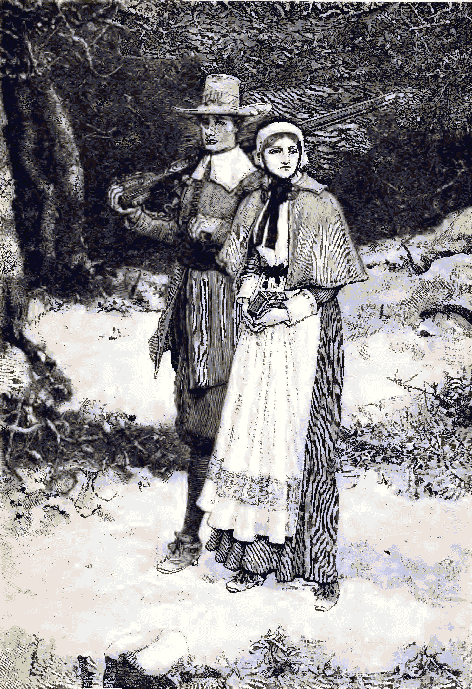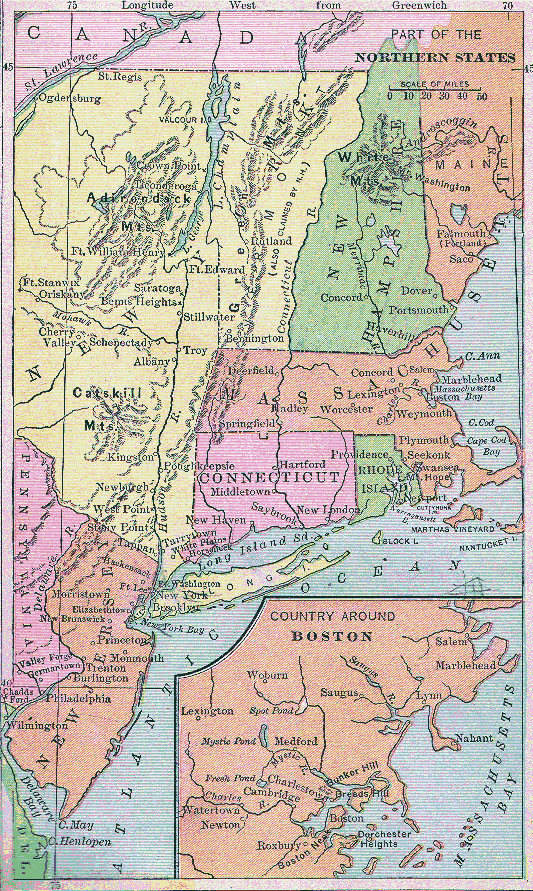Story of the Thirteen Colonies - Helene Guerber |
The Snake Skin and the Bullets
As the Pilgrims were just in all their dealings with the Indians, and honestly paid them for the corn taken when they first landed, the natives became quite friendly. They not only brought back the missing tools, but once found and carried home the mischievous Billington boy, who had lost his way in the forest, near the pond which still bears his name.
The Indians felt such respect for the Pilgrims that when Massasoit fell ill he sent for Winslow right away. The latter went to the chief's wigwam, where he found a crowd of Indians eagerly watching the antics of the medicine man, who had come to drive away the chief's disease.
After ordering all the Indians out of the wigwam, Winslow let in some fresh air, cooled the sick Indian's hot brow and hands with clean water, and gave him some medicine. Presently the savage chief asked for chicken broth, which he had once tasted at Plymouth, so Winslow sent a messenger to Plymouth for a fowl. Thanks to Winslow's good nursing,—for fresh air and cleanliness are good doctors,—Massasoit soon recovered, and ever after he was the white men's firm ally.
All the Indians were not friendly, however. Canonicus, chief of the Narragansetts, an enemy of Massasoit, hated to see the land occupied by the English, so he soon sent them a rattlesnake's skin full of arrows. Governor Bradford looked at it wonderingly and then asked Squanto what it meant. The Indian said it signified that unless the white men crept away like serpents the Indians would slay them all with their arrows.
Hearing this, Bradford coolly took the arrows out of the skin, stuffed it full of powder and bullets, and silently handed it to the messenger to carry back to Canonicus. The savage glided rapidly away, and gave the skin to Canonicus, who, afraid of the powder, passed it on to another Indian. The snake skin went thus from hand to hand, but was finally sent back to Plymouth, with an offer of friendship. The Indians, seeing that the English governor was not afraid of them, now begged for peace, promising to bury the war hatchet so deep that it could never again be dug up.
The fact is that powder at first seemed a very mysterious thing to the red men. They were afraid of it, but at the same time longed to have some. One Indian is said to have bought powder from a colonist, who gravely told him that if he wanted any more he must plant the black seed. The savage obeyed, but as nothing came up from it, the shrewd Indian declared that he would pay the colonist only when the powder grew!
The Pilgrims, fearing the Indians might attack them, built a log meetinghouse on a hill, and used it as a fort, placing their cannon on its flat roof. This place was also surrounded by a palisade, or great fence of tree trunks, so that it could afford the colonists a safe shelter in time of danger. Generally, however, it served as a meeting-house, for the Pilgrims were all very religious, and when the drums beat on Sunday morning all came out of their houses and marched in solemn procession to church.
At the door the men stacked their arms, leaving them in charge of a guard, who was to give the alarm at the first sign of danger. In the meetinghouse men and women sat apart, listening to the long prayers and sermons, or slowly singing very sober hymns. The boys sat on the pulpit steps, in full view of the congregation, to make sure they would behave properly.
The sexton, armed with a long stick, rapped the boys on the head if they proved unruly, or poked the men when they fell asleep. But if the girls or women dozed, he gently tickled their cheeks with the foxtail hanging at the other end of the same stick. Sometimes, too, it was he who turned the hourglass when all its sands had run out, for the minister was then only halfway through his two hours' sermon.
In the first fall the colony was increased by the arrival of more Separatists; but it did not really prosper until the settlers bought the shares of the English merchants, and, instead of holding everything in common, began to work each for himself. They were so industrious and thrifty that before long their debts were all paid, and they had comfortable homes and good farms.
 PILGRIMS GOING TO CHURCH. |
The Plymouth people were so strict that they would allow none but church members to vote. Their colony therefore grew very slowly, and at the end of ten years it numbered only about three hundred souls. But other Puritans, who did not believe exactly as the Plymouth colonists, came over to America and founded other colonies along the New England coast.
Thus, for instance, the first Massachusetts Bay colonists came over in 1628. As their hope was to convert the Indians, they adopted a seal on which there was an Indian, with the inscription, "Come over and help us." They, too, were very strict. They said, "No idle drone may live among us," and expected every one to work hard. They settled at some distance from Plymouth, in a spot which they called Salem ("Peace"), because they hoped to live and worship there in peace.

The principal man in the Massachusetts Bay colony was John Endicott. He felt such intense horror for the Roman Catholic religion that before he had been in America very long, he drew out his sword and cut the cross right out of the English flag, saying that Puritans could not look with respect upon such a popish emblem. Besides, hearing that some English colonists had put up a Maypole on Merry Mount, and danced there, he cut down the pole and scolded the people for indulging in "the folly of amusements."